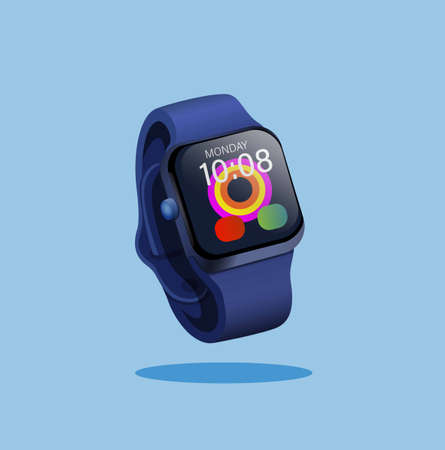1. Understanding the Basics: GPS Watches vs. Handheld GPS Units
If you’re a hiker in the U.S., chances are you’ve seen both GPS watches and handheld GPS units out on the trail. But what’s really different about them, and how do you know which one suits your needs? Let’s break down the basic features and differences between these two popular navigation tools.
What Is a GPS Watch?
A GPS watch is a wearable device that sits right on your wrist, much like a regular watch. It tracks your location using satellites, records your hiking routes, monitors your pace, and often includes health metrics like heart rate. Most modern models can sync with your smartphone for notifications and app integration.
What Is a Handheld GPS Unit?
A handheld GPS unit is a portable device about the size of a walkie-talkie or small phone. You carry it in your hand or clip it to your pack. These units focus mainly on navigation, offering detailed topographic maps, robust tracking features, and often a longer battery life compared to watches.
Main Differences at a Glance
| Feature | GPS Watch | Handheld GPS Unit |
|---|---|---|
| Wearability | Wrist-worn, lightweight | Handheld or clipped to gear |
| Battery Life | 8-60 hours (varies with model) | 20+ hours; can swap batteries |
| Screen Size | Small display (1-2 inches) | Larger display (2-4 inches) |
| Navigation Features | Basic mapping, breadcrumb trails | Detailed topographic maps, waypoint marking, route planning |
| Toughness/Weather Resistance | Water-resistant, durable for daily wear | Built for rugged use; often fully waterproof & shockproof |
| User Interface | Buttons/touchscreen; menu-driven | Physical buttons; easier with gloves/on rough terrain |
| Add-Ons & Extras | Heart rate, fitness tracking, smart notifications | Two-way radios (on some models), SOS beacons, external antenna support |
| Price Range (USA) | $150-$900+ | $120-$700+ |
The Bottom Line on Features
If you value convenience and multi-functionality (like fitness tracking), a GPS watch might be your go-to. If you need detailed navigation for off-trail adventures or backpacking in remote U.S. wilderness areas, a handheld GPS unit offers more specialized features. In the next section, we’ll dig deeper into real-world pros and cons of each device for American hikers.
2. Portability and Ease of Use on the Trail
When you’re hitting popular U.S. trails like the Appalachian Trail or local state park loops, your gear choices matter. Let’s break down how GPS watches and handheld GPS units fit into your hiking routine, especially when it comes to size, weight, and how easy they are to use while moving.
Size and Weight: Pack Light, Move Fast
For most American hikers, every ounce counts. Here’s a quick comparison:
| Device | Average Weight | How You Carry It |
|---|---|---|
| GPS Watch | 1-3 oz (about as much as a Clif Bar) | On your wrist—always ready |
| Handheld GPS Unit | 5-8 oz (closer to a headlamp or small water filter) | Pocket, hip belt, or backpack strap—needs to be taken out to use |
GPS watches are all about convenience. You strap one on at the trailhead and forget it’s there until you need it. Handheld units are bulkier and can feel clunky if you like to move fast or keep your hands free for trekking poles or scrambling over rocks.
User Interface: On-the-Go Navigation
The way each device works also changes how easily you can use it mid-hike:
GPS Watches
- Quick Glance Data: Real-time stats (distance, elevation gain, pace) right on your wrist.
- Button or Touch Controls: Simple navigation through menus; some models work with gloves.
- Less Detailed Maps: Most show basic breadcrumb trails, not full topo maps.
Handheld GPS Units
- Larger Screen: Easier to view detailed topographic maps and plan routes on the fly.
- Two-Hand Operation: Typically requires stopping and using both hands.
- Physical Buttons & Touchscreen: Some models offer both, but touchscreens can be tricky in cold weather or with gloves.
The Typical U.S. Hiking Scenario
If you’re day hiking in Shenandoah National Park or section hiking in Colorado, a GPS watch keeps things streamlined—just check your stats without breaking stride. If you’re bushwhacking off-trail in the Rockies or planning complex backcountry trips, a handheld unit’s bigger screen and detailed mapping might save the day.

3. Battery Life and Durability in American Wilderness
When it comes to hiking in the diverse landscapes of the United States—from the humid forests of the Pacific Northwest to the sunbaked deserts of Arizona—having reliable gear is a must. Two key factors that can make or break your hike are battery life and durability. Let’s take a closer look at how GPS watches and handheld GPS units perform during long treks through America’s wild places.
Battery Longevity: Which Lasts Longer?
Battery life is a big deal for hikers, especially if you’re planning multi-day trips or tackling trails with little access to charging options. Here’s a quick comparison:
| Device Type | Average Battery Life (Active GPS Use) | Charging Options |
|---|---|---|
| GPS Watch | 10–40 hours (varies by model and settings) | USB charging, power banks, solar panels |
| Handheld GPS Unit | 15–30 hours (replaceable AA/AAA batteries or rechargeable packs) | Swappable batteries, USB charging, solar chargers |
While many GPS watches offer impressive battery life in standard mode, battery drain can be faster when using advanced tracking features or color maps. Handheld units often let you swap out batteries on the fly, which is super handy for longer backcountry trips where plug-in charging isn’t possible.
Durability: Built for Rough Trails
The U.S. wilderness can be tough on gear—think rainstorms in the Rockies, rocky scrambles in Yosemite, or dusty paths in Utah. Both GPS watches and handheld units are designed to take some abuse, but there are differences:
- GPS Watches: Many are built with rugged cases, scratch-resistant screens, and water resistance (some even up to 100 meters). They’re made to stay on your wrist through thick and thin.
- Handheld GPS Units: Usually feature robust casings, rubberized grips, and high levels of water and dust resistance. Their bulkier design can better absorb drops and bumps from being tossed in a pack or dropped on rocks.
What About Extreme Weather?
If you’re hiking in freezing temperatures or extreme heat—a reality on some U.S. trails—handheld units may have an edge. Cold weather can zap watch batteries faster, while handhelds let you keep spare batteries warm in your pocket until needed.
The Bottom Line on Trail Toughness
No matter which device you pick, always check its IP rating (for water/dust resistance) and user reviews for real-world durability. Think about where you’ll hike most often: Will you face sudden downpours? Extreme cold? Rugged terrain? Choosing the right device for your favorite American trail environments means fewer worries and more time enjoying the great outdoors.
4. Navigation Accuracy and Map Features
When it comes to hiking popular trails in the U.S.—like the Appalachian Trail, Pacific Crest Trail, or the Rockies—navigation accuracy and map features can make a huge difference. Both GPS watches and handheld GPS units have their strengths, but which one typically gives you better navigation and mapping capabilities out on the trail?
GPS Watches: Quick, Convenient, but Limited Maps
Modern GPS watches are incredibly convenient for hikers who want quick access to location data. They’re worn on your wrist, making it easy to check your route, distance, and elevation gain with just a glance. Some high-end models (like the Garmin Fenix series) offer basic topographic maps and breadcrumb-style navigation. However, the screen size is small, so map details are limited. These watches usually excel at tracking progress but may fall short when you need to study complex terrain or plan off-trail detours.
Handheld GPS Units: Superior Mapping and Detailed Navigation
Handheld GPS devices are built for serious navigation. They feature larger screens, detailed color topographic maps, and often support custom map downloads (such as USGS or National Geographic maps). This means you can zoom in on specific trail sections or landmarks, mark waypoints, and get turn-by-turn directions even in dense forests or canyons where cell service disappears. Handhelds generally provide more accurate positioning because they use bigger antennas and sometimes support multiple satellite systems (like GPS + GLONASS).
Real-World Comparison Table
| Feature | GPS Watch | Handheld GPS Unit |
|---|---|---|
| Screen Size & Detail | Small, basic maps | Large, detailed topo maps |
| Navigation Accuracy | Good (sufficient for marked trails) | Excellent (precise even off-trail) |
| Custom Map Uploads | Limited support | Wide support (USGS/NGS maps) |
| Waypoint Management | Basic (few waypoints) | Advanced (hundreds of waypoints) |
| User Interface | Simplified for quick glances | Detailed menus for planning & analysis |
| Batter Life w/ GPS Use | Shorter (8-40 hours) | Longer (up to 30+ hours with replaceable batteries) |
What Hikers Notice Most on U.S. Trails
If you’re tackling well-marked trails like those in Yosemite or Shenandoah National Park, a GPS watch might be all you need for tracking your stats and staying on route. But if you plan to explore less-traveled backcountry routes or want extra confidence navigating through confusing junctions or bad weather, most American hikers find that handheld GPS units offer better accuracy and more robust mapping tools.
5. Price, Value, and Best Picks for Different Hiker Types
When it comes to picking between GPS watches and handheld GPS units, price and value are big factors for American hikers. Let’s break down the cost-effectiveness of each option and see which device fits your hiking style best.
Comparing Costs: GPS Watches vs. Handheld GPS Units
| Device Type | Average Price Range (USD) | Main Features | Typical Battery Life |
|---|---|---|---|
| GPS Watch | $200 – $800+ | Wearable, fitness tracking, compact navigation, smart notifications | 1-2 days (smart mode), up to 2 weeks (GPS mode varies) |
| Handheld GPS Unit | $150 – $600+ | Larger screen, detailed maps, rugged build, longer battery options | 15-30+ hours (replaceable batteries) |
Best Value Recommendations by Hiker Type
For Casual Hikers & Day-Trippers
If you’re mostly hitting well-marked trails or local parks on weekends, a GPS watch gives you plenty of value. You’ll get reliable navigation, fitness tracking, and everyday use all in one package. You don’t need to splurge on top-tier models; a mid-range Garmin Forerunner or COROS Pace covers the basics without breaking the bank.
For Thru-Hikers & Long-Distance Adventurers
Thru-hikers who spend weeks or months on trail will appreciate the durability and long battery life of a handheld GPS unit. Models like the Garmin GPSMAP series or eTrex let you swap out AA batteries in the field—huge when you’re far from outlets. Many also come with preloaded topo maps and waypoint features that make route planning easier. In the long run, these devices offer great value for tough journeys.
For Backcountry Explorers & Off-Trail Pros
If you’re venturing deep into remote wilderness or off-trail areas where navigation is serious business, a high-end handheld GPS is hard to beat. Advanced mapping, weather resistance, and SOS capabilities give you peace of mind. Look for units with satellite communication like the Garmin inReach if you need emergency contact features.
Quick Reference Table: Which Device Fits Your Hiking Style?
| Hiker Type | Recommended Device Type | Why? |
|---|---|---|
| Casual Hiker/Day-Tripper | GPS Watch (Mid-range) | Lightweight, multi-use, affordable, suitable for short hikes |
| Thru-Hiker/Long-Distance Backpacker | Handheld GPS Unit (Rugged model) | Extended battery life, replaceable batteries, durable build |
| Backcountry Explorer/Off-Trail Pro | High-End Handheld GPS (+ Satellite messaging if needed) | Advanced navigation, safety features, maximum reliability in remote areas |
The American outdoor market offers plenty of options at every price point—just match your hiking habits to the right device type to get the most value for your investment.


